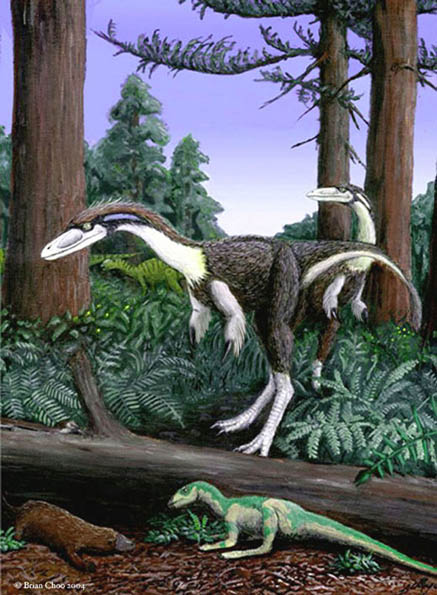
c. 105 million years ago, Lightning Ridge, New South
Wales
A selection of animals known from opalised fossil fragments recovered from Lightning Ridge, NSW. All these creatures are based on isolated bits and pieces so it must be stressed that these are hypothetical reconstructions. Hey, thats part of the fun of doing palaeoart!
The two big feathery bipeds dominating the scene are Rapator ornitholestoides , known from a single hand bone. Recent comparisons have suggested that the specimen may be the manual phalanx of an alvarezsaurid, a group of bird-like theropods known from South America and Mongolia. If so, then Rapator is the biggest alvarezsaur ever discovered and would have been about 6 m in length.
Alvarezsaurs like the Asian Mononykus were exceedingly weird animals with enlarged, hook-like foreclaws, bird-like skulls filled with tiny teeth and a covering of feathers or feather-like filaments. Most were small animals of about 1 m in length that probably ate insects. What an alvarezsaur the size of Rapator ate – if that is what this creature was – is anyone’s guess.
The small dinosaur in the foreground is Fulgurotherium australe, a small ornithopod known opalised thigh-bones. The rest of the animal is based on the completely known UK ornithopod Hypsilophodon.
The large dinosaurs in the background are Muttaburrasaurus sp., known from fairly complete material from Queensland. The presence of this big ornithopod at Lightning Ridge is based on isolated teeth.
Rooting around in the foreground is the mammal Steropodon galmani . This ancient monotreme is known from a jaw fragment that suggest an overall length of close to 1 m, making this one of the biggest of Mesozoic mammals.
 Back to main page
Back to main page
Art and text © Brian Choo2004
A selection of animals known from opalised fossil fragments recovered from Lightning Ridge, NSW. All these creatures are based on isolated bits and pieces so it must be stressed that these are hypothetical reconstructions. Hey, thats part of the fun of doing palaeoart!
The two big feathery bipeds dominating the scene are Rapator ornitholestoides , known from a single hand bone. Recent comparisons have suggested that the specimen may be the manual phalanx of an alvarezsaurid, a group of bird-like theropods known from South America and Mongolia. If so, then Rapator is the biggest alvarezsaur ever discovered and would have been about 6 m in length.
Alvarezsaurs like the Asian Mononykus were exceedingly weird animals with enlarged, hook-like foreclaws, bird-like skulls filled with tiny teeth and a covering of feathers or feather-like filaments. Most were small animals of about 1 m in length that probably ate insects. What an alvarezsaur the size of Rapator ate – if that is what this creature was – is anyone’s guess.
The small dinosaur in the foreground is Fulgurotherium australe, a small ornithopod known opalised thigh-bones. The rest of the animal is based on the completely known UK ornithopod Hypsilophodon.
The large dinosaurs in the background are Muttaburrasaurus sp., known from fairly complete material from Queensland. The presence of this big ornithopod at Lightning Ridge is based on isolated teeth.
Rooting around in the foreground is the mammal Steropodon galmani . This ancient monotreme is known from a jaw fragment that suggest an overall length of close to 1 m, making this one of the biggest of Mesozoic mammals.
Art and text © Brian Choo2004